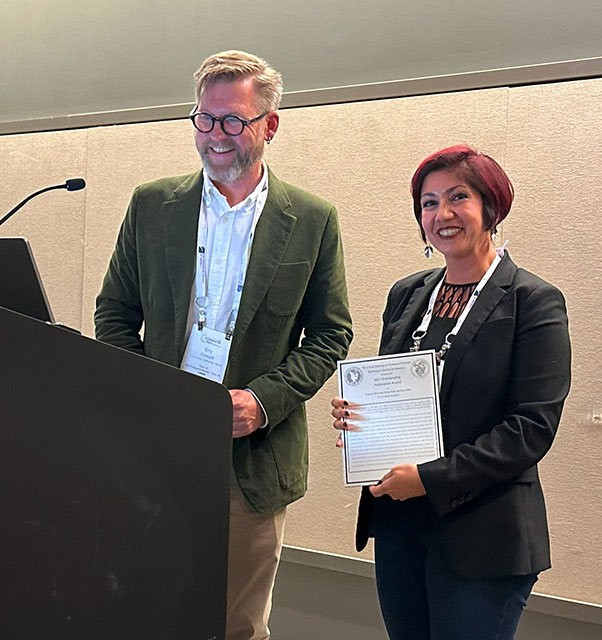CSUN Professor Singled Out for One of Geological Society’s Top Honors

CSUN structural geologist Elena Miranda accepting the Geological Society of America’s Structural Geology and Tectonics Division for its highest publication honor, the Structural Geology and Tectonics Division Outstanding Publication Award, from Eric Cowgill of UC Davis. Photo courtesy of Elena Miranda.
As a student working on her doctorate in geology nearly 20 years ago, Elena Miranda was excited at the prospect of exploring a burgeoning new field of research that could provide insights into the causes of the Earth’s faults and shear zones, key information for understanding earthquakes and other tectonic movements.
But Miranda, one of only a handful of Latinas in such a Ph.D. program at the time, was discouraged from pursuing that field of study. Advisors said she didn’t have what it took to succeed. Miranda, now a professor of geological sciences at California State University, Northridge, disagreed.
She taught herself the subject and is now considered a leading structural geologist in the field of electron backscatter diffraction (EBSD)—a scanning electron microscopy technique used to study the crystalline structure of materials. One of her papers, published in 2016, was singled out last month (October) by the Geological Society of America’s Structural Geology and Tectonics Division for its highest publication honor, calling it “of exceptional distinction that clearly advances the science of structural geology or tectonics.” The paper features the first EBSD data to come out of Miranda’s lab at CSUN. Miranda is the first Latina and only the seventh female lead author to receive the award.
“I am over the moon about this honor because the paper on which it was based has a back story,” Miranda said. “I am one of the most stubborn people I know. I found it unacceptable to be treated like an incapable Ph.D. student, that my advisors did not expect much of me. I knew I would be capable of great work if I was just given the chance. If no one was going to teach me, then I was going to teach myself. I wanted to show that I could become an expert despite everything that was thrown at me.”
Miranda’s paper—“Microstructural evidence for the transition from dislocation creep to dislocation-accommodated grain boundary sliding in naturally deformed plagioclase” was published in the Journal of Structural Geology—was nominated by geologists across the country who said it was integral part of their teaching and provided a foundation for their own research. It was awarded the Geological Society of America’s Structural Geology and Tectonics Division Outstanding Publication Award. The society was founded in 1888 and is the oldest and the largest geological professional society in North America, with more than 22,000 members. The publication award was first given in 1984.
“To see the list of previous awardees is quite humbling,” Miranda said. “Some of the greatest and most impactful papers in my discipline are listed as awardees on the society’s website, and my publication is now among them.”
Miranda originally trained as a marine geologist, and spent time doing submersible dives on the ocean floor studying mid-ocean ridges and ocean basins to understand tectonic deformation. While doing this research, she learned about a relatively new field of study involving electron backscatter diffraction analysis.
“I came from marine geology, so I knew how to identify microstructures really well with light microscopes,” Miranda said. “But this electron backscatter diffraction analysis was something else. I knew this technique was the future of being able to do microstructural analysis.”
Miranda spent hundreds of hours on her own, learning EBSD. Eventually, with the support of Jerry Stinner, dean of CSUN’s College of Science and Mathematics, she established the Department of Geological Sciences’ Scanning Electron Microscopy Lab as a collaborative user facility with EBSD analysis capability. There, she uses EBSD to understand the causes of movement along faults and shear zones that can cause earthquakes and other tectonic movements.
“We use this technique to look at how strong or weak fault rocks are within a fault or shear zone because that’s where a break in the material can lead to earthquakes,” she said. “By using EBSD, we have some insight into seismic risk. We can interpret the ways in which these shear zones have moved in the geologic past. We can use it to interpret past plate motions, past movements along fault lines and the character of the deformation that we find. The technique allows us to interpret temperature, the stresses being put on the rock and how large those stresses are. We can quantify and use equations that describe the behavior of these materials to predict how strong and how fast that material is going to move.”
Miranda said she is particularly proud to receive the honor as a member of the California State University faculty.
“I might be one of the only recipients who did the work at a master’s-granting institution,” she said. “People like us don’t usually get awards like this. But I did, and I hope there will be others like me—Latinas, women and people of color working at master’s-granting institutions—who will get recognized in the future for their work, too.”

 experience
experience